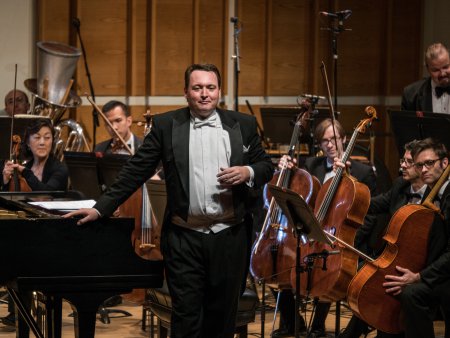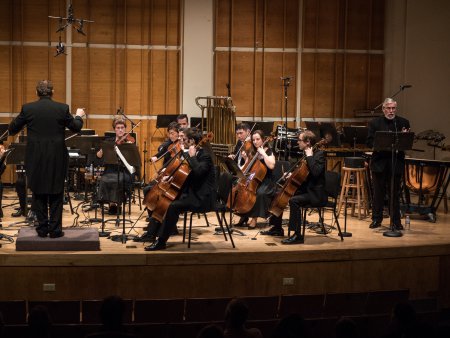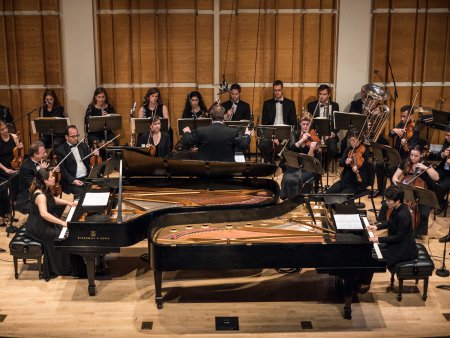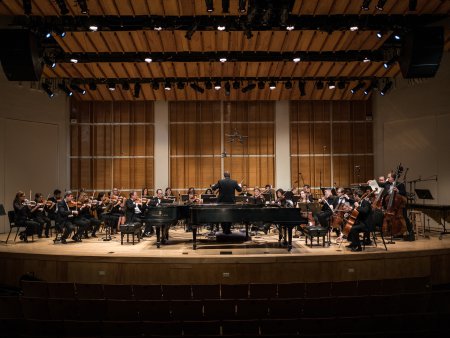SONOS Chamber Orchestra (May 24, 2016)
A thrilling evening of international music – recent compositions and world premieres – from an innovative American chamber orchestra led by a dynamic Finnish-American conductor.

Music director and conductor Erik Eino Ochsner and SONOS Chamber Orchestra at Merkin Hall (Photo credit: Paul Olivier Doury)
[avatar user=”Jean Ballard Terepka” size=”96″ align=”left” ] Jean Ballard Terepka, Music Critic[/avatar]The SONOS Chamber Orchestra, founded in 2000, has a more-than-ambitious mission. It “strives to be a vibrant alternative in the New York City cultural landscape … to discover adventurous works that offer artistic strength … and to expose audiences to the value of these compositions.” Beginning its work in Washington Heights, Inwood and the Upper East Side, SONOS has cultivated diverse audiences in both traditional and non-traditional venues; the SONOS repertoire stretches chronologically from the Renaissance to right now and includes both famous masterworks and little-known, neglected pieces.
SONOS co-founder and now Music Director and Conductor Erik Eino Ochsner maintains a dizzyingly busy schedule: in addition to conducting all over the world, and directing SONOS, he is Artistic Director of The Dranoff International 2 Piano Foundation, based in Miami, Florida. In some respects, Ochsner is a traditional musician: disciplined craftsmanship, technical versatility and artistic integrity are at the core of what he expects of both himself and the musicians he works with. But Ochsner has a certain daring to him, as well: under his direction over the last sixteen years, SONOS has produced four commissioned works, two world premieres, 13 United States premieres and three New York premieres.
SONOS’ recent marvelous program was typically exciting: it included one New York premiere, two United States premieres, two world premieres of new versions of contemporary works, and one world premiere of an entirely new work.
In the program notes and in informal remarks to the audience, Ochsner encouraged the audience to listen to all the works as music inspired by nature; this theme proved to be a useful organizing device for the concert. It was both literal – stars, storms, forest transformations and water events – and allusive: the vocabulary of nature works as well for human psychology as for meteorology. The size and composition of the 36-member chamber orchestra made both intimacy and grandeur possible.
The opening piece was the five-minute long Starburst for strings by New York composer Jessie Montgomery (b. 1981). This short piece was entirely successful as a sound poem: even without the work’s title, the listener could immediately hear – and visualize – in the strings’ fine playing all sorts of shooting stars, falling comets and fireworks-surprises. The piece opened with sparkling cascades of sound; various patterns of melody and rhythm revealed themselves and then faded out as the music shifted from fast fire and sudden bolts, to liquid, smooth descent and then settled, uncluttered quiet.

Music director and conductor Erik Eino Ochsner and actor Edward Stone with SONOS Chamber Orchestra at Merkin Hall (Photo credit: Paul Olivier Doury)
The second piece of the evening was the most unexpected … and oldest. Jean Sibelius (1865-1957) had a long standing fascination with the dark folk-tale “The Wood Nymph” set to poetry by Viktor Rydberg (1828-1895) in 1882. In this version, receiving its New York premiere, the work is written for piano, two horns, string orchestra and a speaker who tells the tale: this is music of romance, mystery and myth, carrying a story of seduction “in the singing woods,” where nature, the wood nymph, transforms a man – “there, a breast heaves” – and he is forever after ruined for all mortal women, incapable of functioning in the regular world. The lyrical, sensuous cellos told the story of wood nymph’s power; the crisis of the man’s alteration is conveyed by a dense, orchestral drama; in the end, mysteriously poignant chords – a Sibelius trademark: moody sadness rendered seductively beautiful – mark the man’s longing, in old age, for death and, perhaps, simultaneously, a reliving of the transformative deep forest experience.
As the orchestra played, actor Edmund Stone read the story out loud: he read dramatically and effectively, eliciting from the somewhat stolid text all its possible nuances without losing respect for the charms of its old-fashioned tone.
Sibelius’ music is somewhat dated; the poem does not match the richness of the mythic material. But it’s a satisfying piece, nonetheless: at several moments, the lush, dark musical beauty evoked the dangerous pleasures of being seduced … in a relatively safe late nineteenth century style.
Aurora Borealis by Alexander Brott (1915-2005), receiving its United States premiere, brought the audience back from narrative to description: here, a dramatic landscape was alternately illuminated by lyrical light and then drenched by the sheer density of orchestral sound. Weather – storm and then calm – and seasons were examined for their cyclicality. The concluding symphonic hugeness of the last two minutes (of this evocative six minute piece) presented both a wild unleashing of natural power and the composer’s happy sense of creative achievement.
Ochsner has written in the program notes and elsewhere about the importance of astute and intentional listening in audiences. The first three pieces on this program were felicitous and lovely. The fourth piece, the last in the first half, the Chamber Symphony, Op. 97 by Pehr Henrik Nordgren (1944-2008) was tough to listen to. But rewarding. Written in 1996, this 20 minute piece is an exploration of anguish and suffering: its exceptionally difficult music, requiring the very best of SONOS’ by and large very skilled musicians, moved from crashes, to plucked out individual melodies, then reinserted in further noise, to brief moments of exhausted quiet. The piece explores a psyche’s painful hurtling between unruly, rabid despair and the richer, deeper subtleties of sustained melancholy; the writing for the strings especially explores a range from abrasive roughness to plaintive distress, and the Asian influences, especially noticeable in the percussion, intermixed with distinctly Scandinavian sounds made this particular suffering universal.

Pianists Yoon-Jee Kim and Jackie Jaekyujg Yoo with SONOS Chamber Orchestra at Merkin Hall (Photo credit: Paul Olivier Doury)
Though without plot in any traditional sense, this piece does have a story to tell: towards the end, as agitation and discord increase to a febrile intensity, the need for some sort of decision-making seems to emerge. This is life-or-death music; it is substantive and demanding, and, in the end, even as bass and percussion sustain their doom-heavy rumbling, flute and violin answer back in an affirmative choice of life, a victorious movement from maybe to yes.
After intermission, there were two very short pieces. Albany Rhythms, composed in 2007, by Paul Moravec (b. 1957), is four minutes of delightfulness: it is a lush, fun, generously accessible piece, big orchestral sweeps are mixed in with relaxed syncopated dance rhythms. Urban busyness and pastoral leisure meet in an open-hearted American landscape.
Canadian composer Alice Ping Yee Ho (b. 1960) originally wrote Dark Waters for woodwind quartet and strings; for this performance, Ho prepared an expanded orchestration of the work, of which this was the world premiere. Using consistently demanding, divergent, difficult music, Ho explored water’s various states and movements, interested especially in processes of transformation. Ho’s music is both cerebral and sensuous; her compositional precision is an elegant instrument for the exploration of nature’s surprises, turning paradox and the unexpected into translucence.
Far and away the largest piece of the evening was Frederik Sixten’s Concerto for Two Pianos and Chamber Orchestra, receiving its world premiere. What a fabulous work!
Bringing together opportunities from both of his directorships, SONOS and Dranoff International, Ochsner used funds given as a legacy to SONOS to commission fellow Scandinavian Sixten to write a two-piano concerto. Ochsner and Sixten have worked together in the past: SONOS premiered Sixten’s Requiem in 2012 and has recorded it as well, contributing to Sixten’s solid international reputation as a sacred music composer. A two-piano concerto, when Ochsner proposed it to Sixten, was “a challenge (he) could not resist.” South Korean pianists Yoon-Jee Kim and Jackie Jaekyung Yoo – known as the duo “Yoo + Kim” since sometime before 2013 when they won the Dranoff Competition – played the brand-new piece as though it had been in their bones for years.
Not that there is anything old about this piece. Although Sixten does not in any way challenge the concerto genre – this is a traditional three-movement piece – it is exciting and fresh. The pianos are in dialog with each other; the orchestra enters the conversation almost immediately, and then there is a rush of excitement among the many instruments as three themes get themselves set in place like a braid, sturdy at the core with errant strands springing exuberantly out into open spaces.

Music director and conductor Erik Eino Ochsner and SONOS Chamber Orchestra at Merkin Hall (Photo credit: Paul Olivier Doury)
This is a dramatically large piece. It opens and closes with an expansive embrace of those elements of Romanticism that can be successfully transplanted into the twenty-first century. It assumes the necessity for rigor and toughness, if only to protect the tender and fresh; in Sixten’s hands, the intelligence required for the successful navigation of contemporary geographies is witty and hardy, not sarcastic or cruel, and the energy is unabashedly bracing and optimistic, even in the face of crisis and darkness.
The middle movement is more introspective than the outer two, and it inhabits some of the same interior spaces that Nordgren’s Chamber Symphony had. But Sixten’s project here isn’t about describing pain; it’s about charting the internal space of the active psyche. There are careening contrasts, paths partially explored, reactions and revisitings, encounters with both confusion and clarity; Sixten’s musical vocabulary is literate and referential, but not in any sense mawkishly derivative. Dance fragments – waltz, tango, flamenco – are mixed in with Romantic pastoral motifs and twentieth century urban flirtation sass; the rich life of Sixten’s described interior includes thorny psychomachia, sunny reflectiveness and grand affirmation.
The conclusion of the concerto was thunderously large and completely thrilling. Yoo + Kim are powerful and virtuosic pianists; they played with unerring eloquence and dynamic technical brilliance. Merkin Concert Hall could barely contain the huge sound.
And then the applause was almost equally loud.
The final piece – what Ochsner called “something like an announced encore” – was the world premiere of an orchestral and two-piano arrangement by composer Jeremy Franklin Goodman of Dave Grusin’s theme to the movie On Golden Pond. Though nothing seemed necessary after the big Sixten piece, this On Golden Pond was charming.
Though this concert contained at least several large, demanding pieces, the evening had an intimate – friends and family – feel to it. Almost everyone in the audience knew at least one person on the stage as well as someone else in the audience; when Ochsner looked out from the stage to address the audience, he could clearly be seen recognizing all sorts of colleagues, friends and acquaintances. Ochsner called Ho to the stage after Dark Waters; Goodman was in the audience and Ochsner acknowledged him; relatives of Ruth Unger, a friend of Ochsner who at her death left a bequest to SONOS, were greeted from the stage; Sixten was there as well. Hugs abounded.
The concert was shaped by musical excellence and by the successful realization of several discrete goals. Contemporary composers, represented by both short, occasional pieces and monumental works, were championed; young artists’ careers were moved forward; neglected music was brought out for renewal. Ochsner uses his own musical gifts and administrative skills not merely to advocate for contemporary music and musicians and to enrich and inspire the lives of all who listen. How lucky we all are.
SONOS Chamber Orchestra (May 24, 2016)
Merkin Concert Hall
129 West 67th Street, in Manhattan
For more information: visit http://www.sonoschamberorchestra.org
Running time: two hours and 15 minutes with one intermission
A thrilling evening of international music – recent compositions and world premieres – from an innovative American chamber orchestra led by a dynamic Finnish-American conductor.





Leave a comment